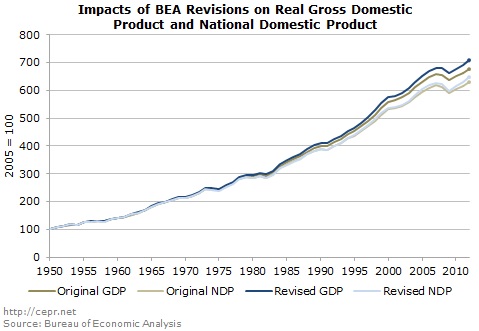July 31, 2013
July 31, 2013 (GDP Byte)
By Dean Baker
The Commerce Department reported that Gross Domestic Product (GDP) growth was 1.7 percent in the second quarter, largely in line with expectations. However, growth in the prior three quarters was revised downward so that the average growth rate over the last year has been just 1.4 percent.
The main driver of second-quarter growth was consumption, which added 1.2 percentage points to growth. Two-thirds of this increase was attributable to a 6.5 percent rise in durable goods purchases. Nondurable goods grew at a 2.0 percent annual rate, while services rose at just a 0.9 percent rate. Part of the reason for slow growth in services was the continuing slowdown in health care spending. Spending on health care services actually edged down slightly as a share of GDP in the second quarter from 11.43 percent of GDP to 11.42 percent.
Investment grew at a 4.6 percent annual rate in the quarter, adding 0.6 percentage points to growth. Residential construction grew at a 13.4 percent annual rate, its fourth consecutive double-digit increase, adding 0.4 percentage points to growth.
The government sector continued to contract, declining at a 0.4 percent annual rate. A 1.5 percent drop in federal spending more than offset a 0.3 percent rise in state and local government spending. The revisions show that government spending has been more of a drag on the economy than had been previously reported. The growth rate of spending was revised down by 0.5 percentage points in both 2009 and 2010 and by 0.7 percentage points in 2011; although growth for 2012 was revised up by 0.7 percentage points.
One distressing sign in the second-quarter data was a 9.5 percent surge in imports. As a result of this sharp rise, trade subtracted 0.8 percentage points from growth in the quarter.
The methodological changes introduced with this report show a somewhat different picture of the economy over recent decades. Including research and development and other intangibles as capital increases GDP by roughly 3.0 percentage points compared with prior measurements. However, the increase in the measured size of the capital stock also means that there will be more depreciation. The new measure added $250 billion to depreciation in the corporate sector for 2012.
One implication of a larger depreciation share in output will be a growing gap between gross and net output. Since net is the measure of what the country has available to consume and has invested for the future, it will be the better measure for many purposes. Also, the net measure has the advantage that insofar as the value of capital has been overstated or understated when initially measured, pulling out depreciated capital for the net measure will largely eliminate the bias.
The new data also show profit shares rising even more than had earlier been reported. The profit share of net corporate output rose to 25.5 percent in 2012, the fourth-highest share in the post-war era. The after-tax share was over 19.0 percent in each year from 2010-2012.
This is a full percentage point below the economy’s potential GDP growth. This growth rate would usually be associated with a rise in the unemployment rather than the decline that we have seen over this period.







